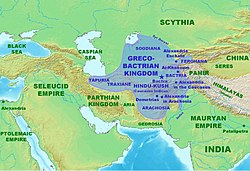
Back مملكة إغريقية بخترية Arabic Yunan-Baktriya padşahlığı Azerbaijani باکتریا یونانی دؤولتی AZB Грэка-Бактрыйскае царства Byelorussian Гръко-бактрийско царство Bulgarian গ্রিক-ব্যাক্ট্রিয় রাজ্য Bengali/Bangla Regne grec de Bactriana Catalan Řecko-baktrijské království Czech Griechisch-Baktrisches Königreich German Ελληνικό βασίλειο της Βακτριανής Greek
Greco-Bactrian Kingdom | |||||||||||||
|---|---|---|---|---|---|---|---|---|---|---|---|---|---|
| 256 BC–c. 120 BC | |||||||||||||
 | |||||||||||||
| Capital | Bactra Ai-Khanoum | ||||||||||||
| Common languages | Bactrian Greek Parthian Sanskrit (religion)[1] Sogdian | ||||||||||||
| Religion | Hellenism Greco-Buddhism Zoroastrianism Hinduism Ancient Iranian religion | ||||||||||||
| Government | Monarchy | ||||||||||||
| Basileus | |||||||||||||
• 256–239 BC | Diodotus I (first) | ||||||||||||
• 117–100 BC | Heliocles I (last) | ||||||||||||
| Historical era | Antiquity | ||||||||||||
• Established | 256 BC | ||||||||||||
• Disestablished | c. 120 BC | ||||||||||||
| Area | |||||||||||||
| 184 BC[2] | 2,500,000 km2 (970,000 sq mi) | ||||||||||||
| |||||||||||||
The Greco-Bactrian Kingdom or simply Greco-Bactria[3][4][a] was a Hellenistic-era Greek state,[5] and along with the Indo-Greek Kingdom, the easternmost part of the Hellenistic world in Central Asia and the Indian subcontinent. It was founded in 256 BC by the Seleucid satrap Diodotus I Soter and lasted until its fall c. 120 BC with some cities still controlled by Greek kings such as Hermaeus Soter (90-70 BC) in what is today Kabul. It was ruled by the Diodotid dynasty and the rival Euthydemid dynasty.
It covered much of present-day Afghanistan, Pakistan, Uzbekistan, Tajikistan, and Turkmenistan, and some parts of Kazakhstan and Iran. An extension further east, with military campaigns and settlements, had most likely reached the borders of the Qin State in 230 BC.[6][7] The capitals of Ai-Khanum and Bactra were among the largest and richest cities of antiquity; indeed, Bactria was itself known as the land of a thousand golden cities. The Indo-Greek Kingdoms, as Bactrian successor states, would last until 10 AD.[8][9][10]
- ^ Baij Nath Puri (1987). Buddhism in Central Asia. Motilal Banarsidass. p. 216.
- ^ Taagepera, Rein (1979). "Size and Duration of Empires: Growth-Decline Curves, 600 B.C. to 600 A.D.". Social Science History. 3 (3–4): 132. doi:10.2307/1170959. JSTOR 1170959.
- ^ The Ancient Greco-Bactrian kingdom and Hellenistic Afghanistan Brewminate, Archived 2021-09-24 at the Wayback Machine - Matthew A. McIntosh
- ^ Mairs, Rachel (2016). "Bactrian or Graeco-Bactrian Kingdom". The Encyclopedia of Empire: 1–4.
- ^ Cribb, Joe (2005). "The Greek Kingdom of Bactria, its coinage and its collapse". Afghanistan Ancien Carrefour Entre Lʼest et Lʼouest: 1 – via Academia.
- ^ Lucas, Christopoulos. Dionysian Rituals and the Golden Zeus of China. Sino-Platonic Papers 326.
- ^ Strabo, Geography 11.11.1
- ^ Doumanis, Nicholas. (16 Dec 2009) A History of Greece[permanent dead link] Palgrave Macmillan ISBN 978-1137013675 p 64
- ^ Baumer, Christoph. (11 Dec 2012) The History of Central Asia: The Age of the Steppe Warriors Archived 2022-11-19 at the Wayback Machine Vol. 1 I.B. Tauris, ISBN 978-1780760605 p 289
- ^ Kaushik Roy. ( 28 July 2015) Military Manpower, Armies and Warfare in South Asia Archived 2022-11-19 at the Wayback Machine. Routledge, ISBN 978-1317321279
Cite error: There are <ref group=lower-alpha> tags or {{efn}} templates on this page, but the references will not show without a {{reflist|group=lower-alpha}} template or {{notelist}} template (see the help page).
© MMXXIII Rich X Search. We shall prevail. All rights reserved. Rich X Search